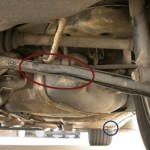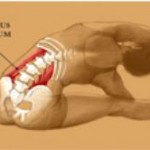What is the meaning of lumbar stabilization and why is it important?
It is important to have a stable lumbar spine (low back) in order to prevent low back pain, dysfunction and disease. The lumbar vertebrae need to stay in normal alignment. By this we mean not too much forward flexion, backward extension, side bending or rotation. This is sometimes referred to as a “neutral spine” position.
The position of the pelvis can influence the alignment of the lumbar spine and contribute greatly to itʼs stability. The pelvis and lumbar spine work together in conjuction. When the pelvis is unstable, the lumbar spine is unstable, when the pelvis is stable so is the lumbar spine.
 What causes an unstable pelvis and lumbar spine? Trauma, pregnancy and delivery, or simple muscle imbalance. This unstable, misaligned pelvis and lumbar spine can not only cause low back pain, but causes a “non-physiological axis of motion” through the lumbar spine which contributes to structural damage and degeneration. What is a “nonphysiological axis of motion”? Think of this disrupted axis as a bent axle of a car. When the axle is bent it causes the tires (or discs) to wear out much faster than normal. Not only do the discs wear out much faster, but all of the structures in your lumbar spine will wear out faster, causing degenerative diseases like degenerative joint and disc disease, osteo arthritis contributing to stenosis, sciatica, scoliosis, etc.
What causes an unstable pelvis and lumbar spine? Trauma, pregnancy and delivery, or simple muscle imbalance. This unstable, misaligned pelvis and lumbar spine can not only cause low back pain, but causes a “non-physiological axis of motion” through the lumbar spine which contributes to structural damage and degeneration. What is a “nonphysiological axis of motion”? Think of this disrupted axis as a bent axle of a car. When the axle is bent it causes the tires (or discs) to wear out much faster than normal. Not only do the discs wear out much faster, but all of the structures in your lumbar spine will wear out faster, causing degenerative diseases like degenerative joint and disc disease, osteo arthritis contributing to stenosis, sciatica, scoliosis, etc.

The Iliopsoas muscle
The muscles that tend to get too tight, short and spasmed that contribute to an unstable pelvis and lumbar spine are the right iliopsoas and left quadratus lumborum muscles. The muscles that tend to become too weak and let the pelvis and lumbar spine become more unstable are the gluteus muscles, the abdominal muscles and the hip abductor muscles.
 One needs to stretch the muscles that pull the pelvis and lumbar spine out of alignment (iliopsoas and quadratus lumborum) and strengthen the muscles that hold them in alignment (gluteus, abdominal and hip abductors). There are other muscles that become spasmed as a result of an unstable lumbar spine and pelvis, however they are usually compensating for the above.
One needs to stretch the muscles that pull the pelvis and lumbar spine out of alignment (iliopsoas and quadratus lumborum) and strengthen the muscles that hold them in alignment (gluteus, abdominal and hip abductors). There are other muscles that become spasmed as a result of an unstable lumbar spine and pelvis, however they are usually compensating for the above.
Body mechanics that tend to create the above mentioned muscle imbalances are prolonged sitting, repeated forward bending, sit-ups, working the latissimus dorsi muscles (including swimming) and backward bending against resistance. Sitting on a wallet can also contribute to an unstable pelvis and lumbar spine
The exercises and stretches in the videos, “The Missing Link to Neck and Back Pain Relief” demonstrate lumbar stabilization so that you can create a healthy spine. This is the first and last step to creating a pain-free life!





